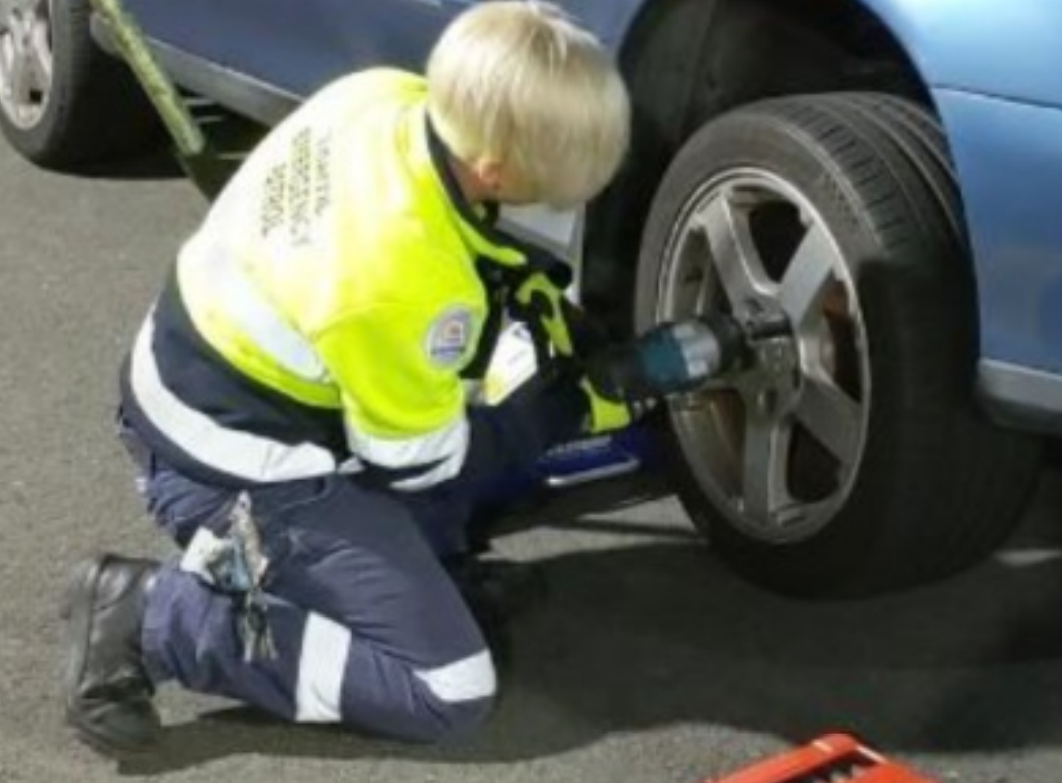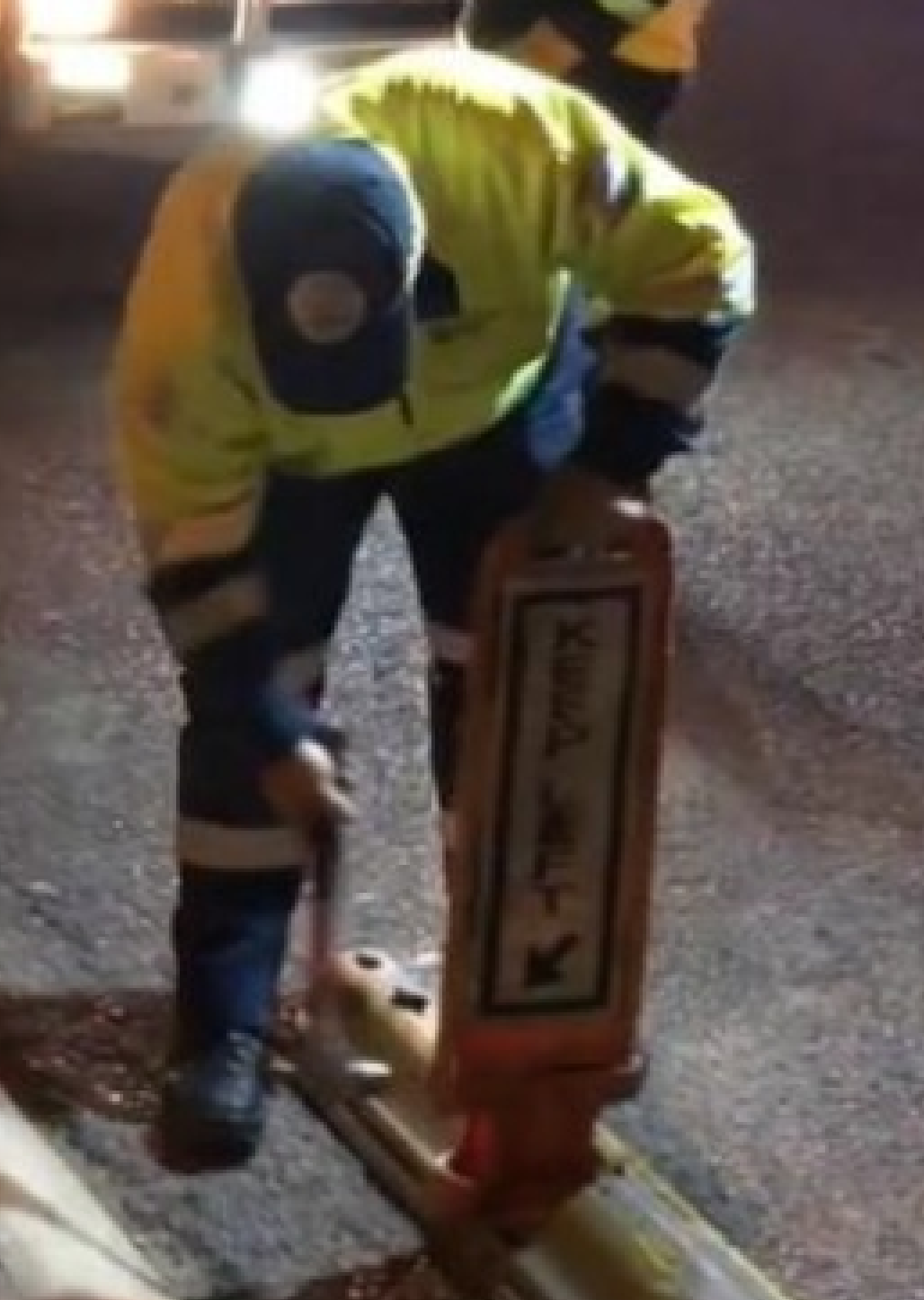Traffic Emergency Patroller - Job Demand Analysis
| Division | Coordinator General |
| Branch | Field Operations |
| Assessment locations | Mooney Mooney Depot (2022), Operational team review (2025) |
| Publication date | 13/08/2025 |
Role Summary
Traffic Emergency Patrollers patrol major road routes and respond to unplanned incidents with the aim of returning the road to normal operating conditions in a timely fashion using safe work practices. This is achieved by providing initial traffic control, reporting incidents, assisting motorists, and keeping the roadway free of minor obstructions. The Traffic Emergency Patroller role and tasks are conducted in pairs.
Exposure To Critical Risks

Task Demand Summary
Task | Physical | Psychological | Environmental |
|---|---|---|---|
| Major route/road patrolling - 55% |
|
|
|
| Jumpstarting or refuelling motorist vehicles - 10% |
|
|
|
| Changing vehicle tyres - 10% |
|
|
|
| Vehicle and equipment check - 5% |
|
|
|
| Cleaning spills - 5% |
|
|
|
| Cleaning debris - 5% |
|
|
|
| Flat towing motorist vehicles - 5% |
|
|
|
| Tidal flow lane changes - 5% |
|
|
|
| Setting up response site - 3% |
|
|
|
| Overall Demand |
|
|
|
Whole Job Physical Demands Summary
| Physical demands | Frequency1 | Comments | ||||
|---|---|---|---|---|---|---|
1. Whole Body Movement | ||||||
| N | R | O | F | C | ||
| Sitting | X | Driving | ||||
| Standing | X | Around response site, while conducting tasks. | ||||
| Walking | X | In and around vehicle, around incident site, walking along road to set up signs and Klemmfix. | ||||
| Kneeling/squatting | X | Inspecting vehicle and equipment, squatting to set up Klemmfix. | ||||
| Climbing - Ladder | X | |||||
| Climbing - Stairs | X | Entering and exiting van. | ||||
2. Lower Back Movement | ||||||
| N | R | O | F | C | ||
| Bending forwards | X | Picking up and pouring drysorb, brooming, clearing debris, setting up Klemmfix, picking up and setting down response site items and equipment. | ||||
| Stooping | X | Setting up klemmfix. | ||||
| Bending backwards | X | |||||
| Twisting/side bend | X | Picking up and pouring drysorb, brooming, clearing debris, setting up Klemmfix, picking up and setting down response items and equipment. | ||||
3. Neck Movement | ||||||
| N | R | O | F | C | ||
| Flexion | X | Bending to pick anything from ground level. | ||||
| Extension | X | Setting up tow. | ||||
| Rotation | X | Observing road traffic and hazards, looking around response site. | ||||
4. Upper Limb Movement | ||||||
| N | R | O | F | C | ||
| Wide grip | X | Handling steering wheel, setting up tow, gripping, gripping fuel cannisters, jump starting kit. Holding broom and drysorb bags, gripping debris, equipment/tools, tyres and Klemmfix. | ||||
| Fine grip | X | Using fine motor skills for connecting leads or buttons. | ||||
| Forward reach | X | Operating vehicle, setting up tow and clearing debris. | ||||
| Overhead reach | X | |||||
| Side reach | X | Reaching for equipment. | ||||
5. Weights and Forces | ||||||
| N | R | O | F | C | ||
| Floor (kg) | 30 | Jump starting kit, 10kg fuel container, tyre jack tool, Klemmfix. | ||||
| Bench (kg) | 30 | Picking trolley jack up. Tyre jack tool. Safety cones. | ||||
| Shoulder (kg) | 25 | Jump starting kit, 10kg fuel container, handling debris and equipment. | ||||
| Above shoulder (kg) | 10 | Placing and retrieving items on top shelves in van. | ||||
| Carrying - Unilateral (kg) | 25 | Carrying trolley jack to 10-20m, jump starting kit, 10kg fuel container, safety signs, weights and cones. | ||||
| Carrying - Bilateral (kg) | 30 | Drysorb bags and tyre jack tool. | ||||
| Pushing (kg) | 10 | Brooming of drysorb over spill. | ||||
| Pulling (kg) | 20 | Repositioning of Klemmfix. | ||||
1: Never 0%; Rare 1 - 5%; Occasional 6 - 33%; Frequent 34 - 66%; Constant 67 - 100%
Whole Job Psychological Demands Summary
| Psychological demands | Frequency1 | Comments | ||||
|---|---|---|---|---|---|---|
1. Quantitative Demands | ||||||
| N | R | O | F | C | ||
| Fast work pace or significant time pressure | X | Requirement to remove hazards from major roads quickly and safely for peak traffic management, rapid set up to mitigate road related hazards and breakdowns. | ||||
| Low job autonomy/control | X | |||||
| Repetitive or monotonous tasks | X | Tasks may be repetitivee in nature. | ||||
| Minimal training/education available | X | |||||
| Minimal tools/resources available | X | |||||
2. Cognitive Demands | ||||||
| N | R | O | F | C | ||
| Requirement to keep focus on multiple items at once | X | Driving, observation/focus on work tasks, roads, hazards, members of the public. | ||||
| Requirement for sustained attention/vigilance | X | Driving on major roads, alertness required for hazards to self and others. | ||||
| Requirement to make difficult or quick decisions | X | Exposure to live traffic situations may require quick or difficult decisions. | ||||
3. Emotional Demands | ||||||
| N | R | O | F | C | ||
| Exposure likelihood to traumatic events | X | Exposure to severe road incidents and fatalities. | ||||
| Customer facing or interacting with the public | X | Engaging with members of the public. | ||||
| Requirement to hide emotional feelings | X | Within teams and with members of the public. | ||||
| Requirement for working in isolation | X | |||||
1: Never 0%; Rare 1 - 5%; Occasional 6 - 33%; Frequent 34 - 66%; Constant 67 - 100%
Whole Job Environmental Demands Summary
| Environmental demands | Frequency1 | Comments | ||||
|---|---|---|---|---|---|---|
1. Physical Environment | ||||||
| N | R | O | F | C | ||
| Uneven, sloped or slippery terrain | X | During wet weather, Terrain may be covered in oil or similar. | ||||
| Hand Arm Vibration | X | |||||
| Whole Body Vibration | X | |||||
| Poor lighting | X | During night shifts, early mornings, evenings or foggy conditions. | ||||
2. Elemental Exposure | ||||||
| N | R | O | F | C | ||
| Working in heat (>30C) | X | Common in summer months. | ||||
| Working in cold (<10C) | X | Common in winter months. | ||||
| Emergency weather conditions/events | X | |||||
3. Hazardous Exposure | ||||||
| N | R | O | F | C | ||
| Dust or other airborne contaminants | X | Dependent on road and weather conditions. | ||||
| Noise | X | Nearby to large vehicles and traffic passing. | ||||
1: Never 0%; Rare 1 - 5%; Occasional 6 - 33%; Frequent 34 - 66%; Constant 67 - 100%
Task 1: Major route/road patrolling - 55%
Physical demand | Psychological demand | Environmental demand |
|
|
|
Task Description
Involves patrolling assigned major routes/roads. This is primarily driving and observing for any members of the public who are in need of assistance due to breakdown, incident or other issues creating traffic hazards on major roads. The TEP vehicle is considered a light rigid heavy vehicle as it has a GVM of >4.5 tonnes but <8 tonnes.
Key Demands
Sitting (C), Rotation (F), Wide grip (C), Forward reach (C), Fast work pace or significant time pressure (O), Requirement to keep focus on multiple items at once (F), Requirement for sustained attention/vigilance (F), Requirement to make difficult or quick decisions (O), Exposure likelihood to traumatic events (O), Working in heat (>30C) (O), Working in cold (<10C) (O), Emergency weather conditions/events (R)


Task 2: Jumpstarting or refuelling motorist vehicles - 10%
Physical demand | Psychological demand | Environmental demand |
|
|
|
Task Description
Involves assisting members of the public who have broken down on major roads due to car battery failure or running out of fuel. Requires the lifting/carrying of fuel canisters and the use of a trolley and lifting of jumpstarting kits.
Key Demands
Stooping (O), Rotation (O), Fast work pace or significant time pressure (O), Requirement to keep focus on multiple items at once (F), Requirement for sustained attention/vigilance (F), Requirement to make difficult or quick decisions (O), Exposure likelihood to traumatic events (R), Customer facing or interacting with the public (C), Uneven, sloped or slippery terrain (O), Working in heat (>30C) (O), Working in cold (<10C) (O), Emergency weather conditions/events (R), Dust or other airborne contaminants (O), Noise (O)


Task 3: Changing vehicle tyres- 7%
Physical demand | Psychological demand | Environmental demand |
|
|
|
Task Description
- Involves assisting members of the public who have encountered a flat tyre on the side of major roads
- Responding to unplanned incidents on roadside
- Reaching underneath vehicle to retrieve spare
- Use of a trolley jack to lift vehicle
- Use of a rattle gun to remove wheel nuts Use of a breaker bar where nuts are stripped
- Manually remove and replace tyres
- May involve communicating with insurance providers, tow drivers
Key Demands
Kneeling/squatting (O), Rotation (O), Side reach (O), Requirement to keep focus on multiple items at once (F), Requirement for sustained attention/vigilance (F), Requirement to make difficult or quick decisions (O), Customer facing or interacting with the public (C), Uneven, sloped or slippery terrain (O), Working in heat (>30C) (O), Working in cold (<10C) (O), Emergency weather conditions/events (R), Dust or other airborne contaminants (O), Noise (O)


Task 4: Vehicle and equipment check- 5%
Physical demand | Psychological demand | Environmental demand |
|
|
|
Task Description
Standard vehicle and equipment inspection occurs pre-start and post-shift. Involves observing and checking that all equipment is available and prepared for the patrol services during shift. Also involves inspecting vehicle tires, any damage, working lights etc.
Key Demands
Kneeling/squatting (O), Climbing - Stairs (O), Fast work pace or significant time pressure (O), Uneven, sloped or slippery terrain (O), Working in heat (>30C) (O), Working in cold (<10C) (O), Emergency weather conditions/events (R)


Task 5: Cleaning spills - 5%
Physical demand | Psychological demand | Environmental demand |
|
|
|
Task Description
- Responding to unplanned incidents to remove spills on the road
- Involves removal of drysorb (10kg bags) from emergency vehicle and walking along incident site to distribute drysorb over the spill
- Depending on size of spill may access/egress emergency vehicle multiple times for drysorb
- Involves using a long-handled steel bristled broom to sweep over drysorb and spill
Key Demands
Climbing - Stairs (O), Stooping (O), Twisting/side bend (F), Extension (O), Rotation (F), Wide grip (C), Fast work pace or significant time pressure (O), Requirement to keep focus on multiple items at once (F), Requirement for sustained attention/vigilance (F), Requirement to make difficult or quick decisions (O), Exposure likelihood to traumatic events (R), Uneven, sloped or slippery terrain (F), Working in heat (>30C) (O), Working in cold (<10C) (O), Emergency weather conditions/events (R), Dust or other airborne contaminants (O), Noise (O)

Task 6: Clearing debris - 5%
Physical demand | Psychological demand | Environmental demand |
|
|
|
Task Description
Sweeping/vacuuming/shovelling debris:
- Responding to unplanned incidents to remove debris on the road
- The task of clearing debris will range from removal of low hanging branches, gravel, animals etc
- Use of various equipment depending on the debris cleared e.g. Leaf blower, brooms, etc.
- May operate a reciprocating saw to cut small branches
Key Demands
Standing (C), Climbing - Stairs (O), Stooping (O), Twisting/side bend (F), Extension (O), Rotation (O), Wide grip (C), Overhead reach (O), Side reach (O), Fast work pace or significant time pressure (O), Requirement to keep focus on multiple items at once (F), Requirement for sustained attention/vigilance (F), Requirement to make difficult or quick decisions (O), Uneven, sloped or slippery terrain (O), Working in heat (>30C) (O), Working in cold (<10C) (O), Emergency weather conditions/events (R), Dust or other airborne contaminants (O), Noise (O)

Task 7: Flat towing motorist vehicles- 5%
Physical demand | Psychological demand | Environmental demand |
|
|
|
Task Description
- Involves basic flat towing services for members of the public who have broken down on major roads. This alleviates traffic pressures and removes traffic hazards from the roads where flat towing has been deemed appropriate.
- Relocating of motorist vehicle to safer location for further assistance or await other emergency vehicles
- A TEP may assist with relocating a vehicle short distances by using a flat tow strap to tow the motorist vehicle using the emergency patrol vehicle
- Use of flat tow: laying on ground to reach underside of vehicle to attach flat tow strap to an appropriate tow point.
Key Demands
Kneeling/squatting (O), Extension (O), Rotation (F), Side reach (O), Fast work pace or significant time pressure (F), Requirement to keep focus on multiple items at once (F), Requirement for sustained attention/vigilance (F), Requirement to make difficult or quick decisions (O), Uneven, sloped or slippery terrain (O), Working in heat (>30C) (O), Working in cold (<10C) (O), Emergency weather conditions/events (R), Dust or other airborne contaminants (O), Noise (O)

Task 8: Tidal flow lane changes- 5%
Physical demand | Psychological demand | Environmental demand |
|
|
|
Task Description
- Walking along the road to erect signs and place/retrieve candy bars or Klemmfix curbs to delineate traffic lanes. This enables efficiency for peak/off-peak traffic flow
- Klemmfix guide curb weighs 16kg and is carried a short distance (no more than 5m) from trailer to road.
- A cover truck drives slowly behind workers as they complete task to provide protection from live traffic
Key Demands
Kneeling/squatting (F), Stooping (F), Twisting/side bend (F), Extension (O), Rotation (F), Wide grip (C), Side reach (O), Fast work pace or significant time pressure (F), Requirement to keep focus on multiple items at once (F), Requirement for sustained attention/vigilance (F), Requirement to make difficult or quick decisions (O), Uneven, sloped or slippery terrain (O), Working in heat (>30C) (O), Working in cold (<10C) (O), Emergency weather conditions/events (R), Dust or other airborne contaminants (O), Noise (O)


Task 9: Setting up response site- 3%
Physical demand | Psychological demand | Environmental demand |
|
|
|
Task Description
- The emergency vehicle will respond to an incident
- The TEP will set up a safety perimeter to decrease the risk roadside incidents when responding to unplanned incidents
- The perimeter of the site and duration to set up will depend on the size of the incident
- Includes setting up cones and safety signs
Key Demands
Climbing - Stairs (O), Stooping (O), Twisting/side bend (F), Extension (O), Rotation (F), Wide grip (C), Overhead reach (O), Fast work pace or significant time pressure (F), Requirement to keep focus on multiple items at once (F), Requirement for sustained attention/vigilance (F), Requirement to make difficult or quick decisions (O), Exposure likelihood to traumatic events (R), Uneven, sloped or slippery terrain (O), Working in heat (>30C) (O), Working in cold (<10C) (O), Emergency weather conditions/events (R), Dust or other airborne contaminants (O), Noise (O)

Key information
Demand rating is calculated via an algorithm based upon the relative weighting and frequency of the physical, environmental and psychological sub-tasks (e.g. squatting has a higher weighting than standing or walking).
This data may vary depending on production rates, changes in design or work organisation and staffing levels. This report was prepared by a trained and qualified health and safety professional within the TfNSW Occupational Health Team and reviewed by relevant Health and Safety, and operational stakeholders.
JDAs are periodically updated by the TfNSW Occupational Health Team or sooner where significant changes have been identified. For the latest version of this JDA, please always refer to this link rather than saving an offline copy.
For further information please contact occupational.health@transport.nsw.gov.au.
